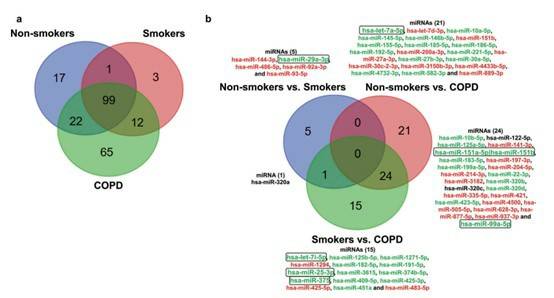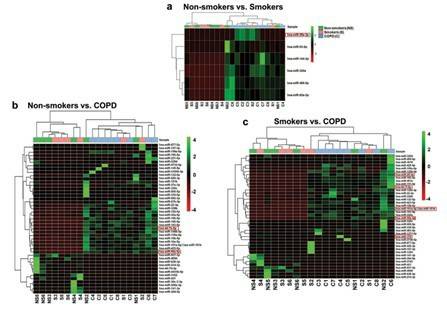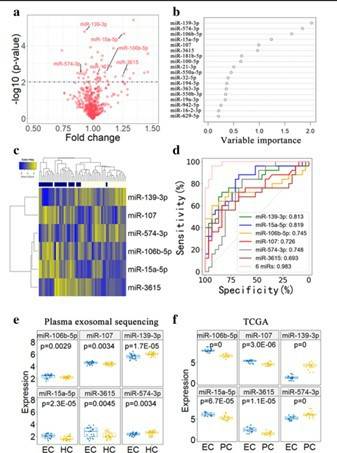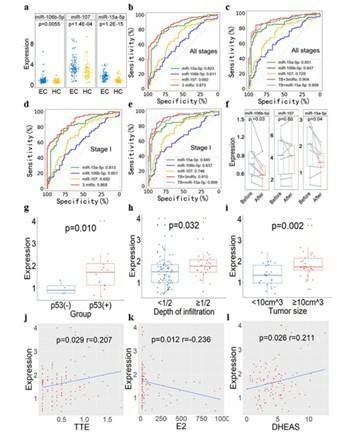Small RNA is a widely present RNA molecule with approximately 21 to 23 nucleotides in eukaryotes. By regulating the transcription and translation of important genes, it plays a crucial role in the pathophysiology of diseases. A small RNA can have multiple targets, which can regulate many key pathways, including various biological functions such as metabolism, growth, development, immunity, etc. Due to its wide range of targets, it can regulate the pathogenesis of various diseases, including cancer.
EV miRNAs are a new biomarker for circulating lung diseases
EVs have been recognized as novel circulating biomarkers of disease, which are released by different cell types. Recently, researchers used different EV isolation and purification methods to characterize the plasma-derived EV miRNAs from non-smokers, smokers and patients with COPD. A small RNA sequencing (RNA-seq) approach was adapted to identify novel circulating EV miRNAs. RNA-seq analysis confirmed the most abundant types of small RNAs, such as miRNAs, tRNAs, piRNAs snRNAs, snoRNAs and other biotypes in plasma-derived EVs. Gene set enrichment analysis (GSEA) of differentially expressed miRNAs revealed the top pathways, gene ontology and diseases associated with smokers and patients with COPD. QPCR analysis was performed on EV and human miRNA panels to further validate the total RNA of the control group and BEAS-2B cells treated with cse. In patients with chronic obstructive pulmonary disease and smokers, gene pool enrichment analysis has identified many important targets that are crucial for controlling the biological processes of cytokine signaling (inflammation), extracellular matrix, and tissue remodeling. Therefore, the molecular map of EV miRNA has enormous transformative potential in developing biomarkers that can be used for the diagnosis, prognosis, and treatment of COPD.
 Venn diagram showing unique and common miRNAs in different groups and differentially expressed miRNA comparisons
Venn diagram showing unique and common miRNAs in different groups and differentially expressed miRNA comparisons
 Hierarchical cluster analysis of differentially expressed miRNAs
Hierarchical cluster analysis of differentially expressed miRNAs
Searching for potential related miRNAs for the diagnosis and treatment of liver fibrosis
Endometrial cancer (EC) is the main cause of death in gynecological malignancies. Due to the lack of effective biomarkers, patients must undergo curettage to obtain accurate EC diagnosis. MiRNA is the most abundant extracellular RNA vector, and extracellular MiRNA usually has tumor specificity. Research has shown that exomiRs have the potential to become effective biomarkers for screening, diagnosing, and monitoring cancer. Small RNA sequencing was performed to identify candidate exosomal miRNAs as diagnostic biomarkers in 56 plasma samples from healthy subjects and EC patients. These miRNA candidates were further validated in 202 independent plasma samples by droplet digital PCR (ddPCR), 32 pairs of endometrial tumors and adjacent normal tissues by quantitative real-time PCR (qRT-PCR), and matched plasma samples of 12 patients before and after surgery by ddPCR. Researchers identified and validated three plasma exomiRs (miR-106b-5p, miR-107, and miR-15a-5p) as potential diagnostic biomarkers for early and late phase EC patients. In addition, by analyzing the expression of miR-15a-5p in other cancer types, including cervical cancer, breast cancer, ovarian cancer and lung cancer, it was found that the expression of miR-15a-5p in EC tumor tissue was much richer than that in other types of tumors. Collectively, plasma-derived exosomal miR-15a-5p is a promising and effective diagnostic biomarker for the early detection of endometrial cancer. The functional study of these diagnostic exosomes helps to reveal the mechanisms underlying the occurrence and development of EC.
 Dysregulated miRNAs in plasma exosomes of EC patients
Dysregulated miRNAs in plasma exosomes of EC patients
 ddPCR validation of plasma exosmal miR-15a-5p, miR-106b-5p and miR-107 as diagnostic markers in 202 independent plasma samples
ddPCR validation of plasma exosmal miR-15a-5p, miR-106b-5p and miR-107 as diagnostic markers in 202 independent plasma samples
The role of small RNA in cancer is an emerging research field due to its relevance in the prognosis, pathogenesis, diagnosis, and treatment of cancer. Recent research has clearly demonstrated the possibility of regulating miRNA to regulate oncogenes and tumor suppressor genes. In vivo research has also established its potential to inhibit tumor growth. The combination therapy of miRNA and chemotherapy drugs can play an effective role in treating cancer cells. By addressing the challenges of target specificity and miRNA delivery, we can accelerate the progress of miRNA transformation research from trials to clinical trials.
References:
-
Menon, Amrutha et al. "miRNA: A Promising Therapeutic Target in Cancer.” International journal of molecular sciences vol. 23,19 11502. 29 Sep. 2022.
- Lu, Qianjin et al. "miRNAs as Therapeutic Targets in Inflammatory Disease.” Trends in pharmacological sciences vol. 40,11 (2019): 853-865.
- Sundar, Isaac Kirubakaran et al. "Small RNA-sequence analysis of plasma-derived extracellular vesicle miRNAs in smokers and patients with chronic obstructive pulmonary disease as circulating biomarkers.” Journal of extracellular vesicles vol. 8,1 1684816. 7 Nov. 2019.
- Zhou, Lanyun et al. "Plasma-derived exosomal miR-15a-5p as a promising diagnostic biomarker for early detection of endometrial carcinoma." Molecular cancer vol. 20,1 57. 29 Mar. 2021.
For research purposes only, not intended for clinical diagnosis, treatment, or individual health assessments.


 Sample Submission Guidelines
Sample Submission Guidelines
 Venn diagram showing unique and common miRNAs in different groups and differentially expressed miRNA comparisons
Venn diagram showing unique and common miRNAs in different groups and differentially expressed miRNA comparisons Hierarchical cluster analysis of differentially expressed miRNAs
Hierarchical cluster analysis of differentially expressed miRNAs Dysregulated miRNAs in plasma exosomes of EC patients
Dysregulated miRNAs in plasma exosomes of EC patients ddPCR validation of plasma exosmal miR-15a-5p, miR-106b-5p and miR-107 as diagnostic markers in 202 independent plasma samples
ddPCR validation of plasma exosmal miR-15a-5p, miR-106b-5p and miR-107 as diagnostic markers in 202 independent plasma samples